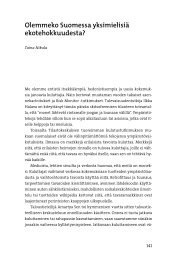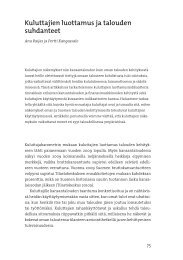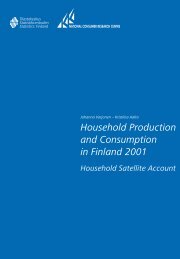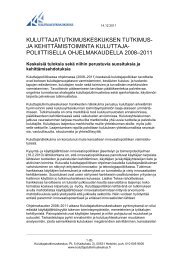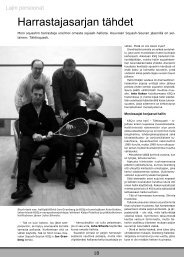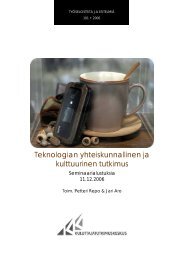Household Production and Consumption in Finland 2001
Household Production and Consumption in Finland 2001
Household Production and Consumption in Finland 2001
Create successful ePaper yourself
Turn your PDF publications into a flip-book with our unique Google optimized e-Paper software.
The data were well suited for the compilation of this <strong>Household</strong> Satellite<br />
Account. A major consideration <strong>in</strong> the process of harmonis<strong>in</strong>g the method of<br />
the European Time Use Survey was to make sure that unpaid work can be<br />
dist<strong>in</strong>guished from leisure <strong>and</strong> personal activities. The Classification of<br />
Individual <strong>Consumption</strong> by Purpose (COICOP), for its part, is highly detailed<br />
<strong>and</strong> provided a sound basis for the necessary classifications; there were only a<br />
few <strong>in</strong>stances where time use or consumption categories had to be divided <strong>in</strong>to<br />
two or more parts on a discretionary basis. These classifications concerned (1)<br />
the allocation of a certa<strong>in</strong> category between different pr<strong>in</strong>cipal functions of<br />
household production <strong>and</strong> (2) the allocation of a certa<strong>in</strong> consumption category<br />
between household production <strong>and</strong> some other activity, such as leisure. The<br />
former classification impacts the relative weight of different pr<strong>in</strong>cipal<br />
functions, but not the total value of household production. The latter impacts<br />
the value of household production.<br />
In the case of time use categories, discretionary classification was required<br />
when allocat<strong>in</strong>g the amount of time spent <strong>in</strong> shopp<strong>in</strong>g <strong>and</strong> services, household<br />
management, <strong>and</strong> to some extent travel related to unpaid work to different<br />
pr<strong>in</strong>cipal functions (see Table 5). In consumption expenditure, the use of<br />
energy <strong>and</strong> water were divided between <strong>in</strong>termediate consumption <strong>in</strong> hous<strong>in</strong>g,<br />
meals <strong>and</strong> cloth<strong>in</strong>g accord<strong>in</strong>g to the average distribution of use (Appendix 8).<br />
Garden<strong>in</strong>g products (garden soils, fertilizers, seedl<strong>in</strong>gs <strong>and</strong> seeds) were divided<br />
<strong>in</strong> half between hous<strong>in</strong>g (decorative garden) <strong>and</strong> SNA food (vegetable garden)<br />
<strong>in</strong>termediate consumption. Among f<strong>in</strong>al consumption products, home care<br />
<strong>and</strong> meal services for the elderly were also split equally between f<strong>in</strong>al care <strong>and</strong><br />
f<strong>in</strong>al meal consumption. These decisions seemed to have a m<strong>in</strong>or impact on<br />
the relative weight of different pr<strong>in</strong>cipal functions, but not on the total volume<br />
of household production.<br />
Discretion was also needed <strong>in</strong> the allocation of <strong>in</strong>termediate consumption<br />
goods <strong>and</strong> services as well as capital goods between household production <strong>and</strong><br />
non-household production. Three per cent of telephone costs, Internet costs,<br />
postal fees, short bus <strong>and</strong> tra<strong>in</strong> trips <strong>and</strong> newspaper subscription fees were<br />
allocated to services (runn<strong>in</strong>g err<strong>and</strong>s). Accord<strong>in</strong>gly, three per cent of<br />
telephone appliances <strong>and</strong> PCs were allocated to capital goods <strong>and</strong> capital<br />
consumption. In the <strong>in</strong>put method used <strong>in</strong> the Satellite Account, <strong>in</strong>termediate<br />
consumption does not affect value added, but the consumption of capital does,<br />
although its share overall is very small.<br />
In the national accounts, household f<strong>in</strong>al consumption of goods <strong>in</strong>cludes<br />
the consumption of both foreign nationals resident <strong>in</strong> F<strong>in</strong>l<strong>and</strong> <strong>and</strong> people liv<strong>in</strong>g<br />
<strong>in</strong> <strong>in</strong>stitutions. <strong>Consumption</strong> by these two groups was subtracted from total<br />
consumption when compil<strong>in</strong>g the Satellite Account. We had access to only<br />
rather crude estimates of these people’s consumption, <strong>and</strong> therefore the<br />
allocation of that consumption to the detailed classification of the <strong>Household</strong><br />
Budget Survey was done on a discretionary basis. This has no significant effect<br />
on the overall end-result, but it might show up <strong>in</strong> <strong>in</strong>dividual categories. In the<br />
future the tourism satellite account will help to shed further light on this<br />
problem. Accord<strong>in</strong>g to <strong>2001</strong> national accounts, these population groups<br />
accounted for around 3 per cent of total consumption expenditure.<br />
72 Statistics F<strong>in</strong>l<strong>and</strong> National Consumer Research Centre




